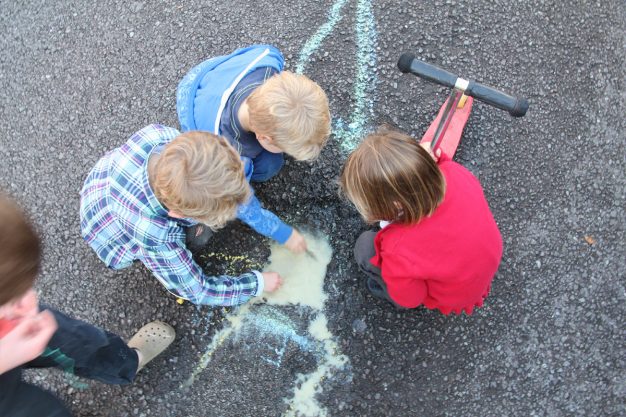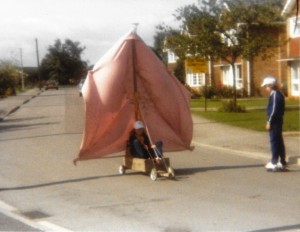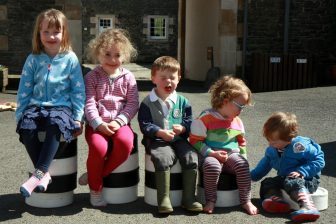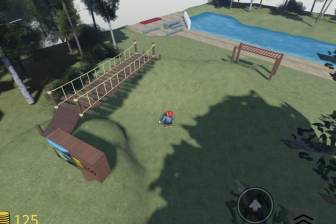
Designing streets for play – research and observation
Many within the UK’s street play movement want to see long-term changes to the design of residential streets, but know they need to marshall the evidence to support their case. Professional architect and Playing Out activist, Helen Forman is well qualified to do just that. In this blog from the Playing Out website, she talks about her new literature review of this area, Residential Street Design and Play, and what inspired her to undertake it.
There’s a house on a corner near where I live in suburban Leeds that makes me happy nearly every time I pass it. Not because it’s anything special architecturally, but because there are almost always children playing in the street outside. Further into town there’s a Victorian terrace, where cycling past once I smiled as I saw two kids playing badminton, using the front wall as a net, one child standing in the street and one in the front yard.
‘Perhaps the ultimate feel-good moment though was a couple of weeks ago, when I happened to be close to the cul-de-sac where I grew up. I turned down it and drove slowly along, reminiscing about the street games I used to play there with my friends and pointing out every feature of its layout and surface to my kids (poor them!). Having that wide open space had inspired so many games and projects, including the go-kart land-ship, built by my brother and his friend on one windy day (and sailed here by me) in the early 1980s. On my revisit, to my delight, I saw a scooter and other toys left out on the pavement – evidence that children still play there!
Freedom, fun and independence
I am a Playing Out Activator and the sessions we have run on our street have engendered a wonderful community spirit and given our children freedom, fun and independence over the last five years. However, I get a thrill when I see playing out that has not had to be facilitated by organised sessions. I’m fascinated by what leads to this  unsupervised play. There are clearly many factors and barriers, including other distractions and demands on children’s time, but there’s no doubt that the outdoor environment around the home has a strong influence on whether children want to play there – and whether their parents are comfortable enough to let them.
unsupervised play. There are clearly many factors and barriers, including other distractions and demands on children’s time, but there’s no doubt that the outdoor environment around the home has a strong influence on whether children want to play there – and whether their parents are comfortable enough to let them.
As an architect in the housing field, the link between residential street design and play is something I’ve been able to study informally throughout my career, but I wanted to look more thoroughly at existing research in this area, to begin to forge a way forward for designing and planning a residential environment that encourages unsupervised play and independent mobility. Playing Out supported my literature review, being driven by a desire to enable more children to freely enjoy the world outside their front door, without the need for physical barriers and organised sessions.
‘Residential Street Design and Play’ is the result. It looks at research carried out over the last 20 years, including a study of play on twelve housing estates across the UK carried out in 1997 by Rob Wheway and Alison Millward ‘Child’s Play: Facilitating Play on Housing Estates’ . It also drew on Mike Biddulph’s observational 2011 study of ten housing developments ‘The impact of innovative designs on activity in residential streets’. It explores the impact of Homes Zones, cul-de-sacs and traffic calming, and makes some recommendations for further action including developing guidance and training for decision makers such as architects, urban designers, house builders, planners and highways engineers.
Enlightening
Writing the review has been enlightening. While I understood before commencing it that traffic was the single biggest issue influencing children’s outdoor unsupervised play, the many more subtle factors at play were a revelation. For instance, children who have free access to their neighbourhood like to move around it in loops – not to stay in one place for long, but to keep walking/scooting/cycling between park, shop, friend’s house etc. They like to play where they can be seen and where the chances of social contact are higher. And a range of play spaces means that different groups of children can play out alongside each other harmoniously.
 Of course, when I thought back, this is exactly how I used my environment as a child, 40 years ago – but it’s surprising how easy it is to forget something which came so naturally. What is worrying is that we no longer recognise this child behaviour as something we see every day. Children are disappearing from our outdoor spaces, with harmful consequences for their physical, social and mental well-being.
Of course, when I thought back, this is exactly how I used my environment as a child, 40 years ago – but it’s surprising how easy it is to forget something which came so naturally. What is worrying is that we no longer recognise this child behaviour as something we see every day. Children are disappearing from our outdoor spaces, with harmful consequences for their physical, social and mental well-being.
The government has a target to build one million new homes by 2020. It is well within our grasp to ensure that new residential developments provide a safe and attractive outdoor environment that children can access without supervision. There are some great examples of simple planning strategies such as The City of Rotterdam’s ‘Building Blocks for a Child Friendly City’ which sets out four principles for design: child friendly housing, public space, facilities and safe traffic routes. We would do well to learn from them in our ‘Child Friendly Cities’ and ‘NHS Healthy New Towns’ initiatives, and indeed to ensure that all new housing considers children’s independent play and mobility as a standard part of the development process.
While I’ll always get a thrill whenever I see children playing out, I would love to not be surprised by it. It’s a big ambition, but one which we can move towards, one step at a time, starting with new housing development.
Helen Forman
Photos: Playing Out
This blog first published by Playing Out
Download Helen’s report here.



